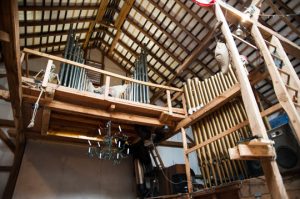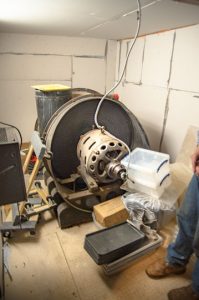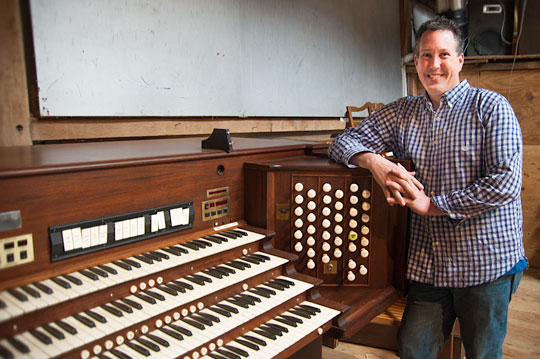The sound of pipe organ music might begin wafting through the air along the Brandywine Battlefield sometime this year.
Randell Spackman, owner of Thornbury Farms, has four sets of pipes, two controllers, and a pair of air blowers in his barn and is eager to put them all together and have some organ music concerts. He said he’s already been talking with people at the Sanderson Museum in the hopes of having a square dance at his barn this summer.
Chris Sanderson used to have square dances there, and Sparkman sees this as a way to bring back more of the farm’s history. The farm was also a part of the battlefield during the 1777 Battle of Brandywine.
Getting the organ up and running is not a sudden passing fancy for Spackman. Coming into possession of the individual pieces has happened over time and is based on his love of the sound.

“I always had a love for pipe organs, the complexity of them. The music [tonal range] was always so full. It has a depth that speakers can’t bring out,” he said.
Spackman, like his late father, Tom, before him, has an abiding interest in preserving the history of the farm and the region, and his interest in the organ falls into that category.
“As I learned about them, I became more inquisitive, and I learned about some organ parts that were going to be cut up and made into tables. I bought them to save them,” Spackman said.
With a little help from friends and others who share his enthusiasm, Spackman formed Thornbury Pipe Organ, a nonprofit organization of volunteers who will refurbish and reassemble all the equipment to bring the full rich sound back to life in a place that’s not a normal concert hall.
“My idea is to have concerts, events, and just have people be able to play the organ here in a different atmosphere…The people who learned about me wanting to have my own pipe organ really identified with that.”
As word spread through a variety of organizations, Spackman learned of other pieces’ becoming available, how they work and what work would be needed to get those various elements working together.
One of the consoles — the part that contains the keyboard and other controls — came from a church in Georgia. That one piece alone weighs a half a ton, he said, and will help control the entire organ, which, he added, will actually be four organs in one.
A second console was designed to play music during the old silent movie days, something Spackman said he wants to be able to do at the barn: show old silent movies and have someone play the organ during the showing.
The four organs are the four sets of pipes, Spackman explained, and they are the valuable part of the organ.
“The consoles are how you work the pipes. They’re the interface. But the soul of the organ is the pipes.”
He has more than 5,000 pipes, some as small as a pencil, others 16 to 18 feet tall, he said.
“Each organ has a story, like a baby book, and I think I’m only the steward,” Spackman said. “A couple of people wanted to buy parts of them, but I don’t want to do that because I want the organs’ integrity to be whole. Once they’re split up, they’re gone forever.”
And what he has, he said, is unique.
“There are only about seven organs like this in the country. It’s very rare to have this eclectic type of combination,” he said.
One of the four organs dates back to the 1880s. That will be incorporated with the other pipes, one dating back to the 1920s, and another that was made in 1918. One set of pipes came from the old Prince Theater in Philadelphia, he said.

Spackman bought pieces as they became available, a process he likened to buying a car one piece at a time, a tire today, a fender tomorrow.
In getting everything ready for the types of concert experience that Spackman envisions, the volunteers of Thornbury Pipe Organ would have a lot to do. He said there’s a lot of wires that need to be soldered to valves, thousands of pipes to be cleaned and other pieces sorted, among other things. They also need to get a five-horsepower air blower to work properly so it can deliver the right amount of air through the pipes.
When asked how long that might take, Spackman laughed and referenced an old TV commercial, “That would be like asking how many licks you need to get to the center of a Tootsie Pop.”
After the joke, he said getting everything up and running together would take several years.
One point that can’t be avoided is economics. It takes money to get it all done. Spackman said the word is getting out and that had resulted in some donations. He speculated that it would take about $100,000 to get the organ operational. Replacing it, though, would cost about $2 million, he said.
Donations are coming in, he said, and more people are offering to help with the work. That could shorten the time frame, but Spackman can’t yet say how much time can be saved.
The next step for Thornbury Pipe Organ, he said, is to become “a consistent volunteer organization with people who are passionate about preserving our musical heritage and mechanical music.”
Anyone interested in helping out or learning more by taking a tour should contact Spackman at www.thornburyfarmcsa.com or by phoning 610-793-2933.


Comments